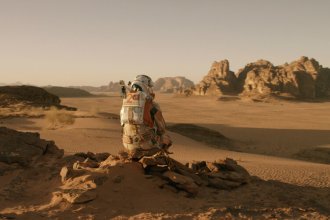“Now this is the Law of the Jungle — as old and as true as the sky…” begins Kipling’s poem in the original Jungle Book. The Law of the Jungle is not just survival of the fittest, it is a recitation of all that brings life and order to the wolf pack. How does the Law of the Jungle apply to a human? Is his place among his own kind or the animals that raised him? In Disney’s newest hybrid/animated/re-envisioned film based on the 1967 cartoon (based on the 1894 anthology by Rudyard Kipling), a parade of creatures must decide what to do with Mowgli, the man-cub, while being hunted by a vengeful adversary. From the mature performance of its only human actor (newcomer Neel Sethi) to its lush visual design, Disney upgrades its classic tale with enough darkness, humor, and adventure to add this movie to a very short list of must-see family films.
Nothing Is Real Anymore, and That’s OK
I cannot say enough about the visual design of The Jungle Book. Director Jon Favreau used words like “mythic” and “surreal” to describe the look he was trying to accomplish. Using bleeding-edge computer-generated imagery Favreau and crew “shot” the entire film in an empty building in downtown Los Angeles (watch the credits for this revelation, which everyone involved  is clearly very proud of). It is technically a live action film, though it is nearly impossible to think of it as such once you understand the sheer amount of CG used to bring it to life. Usually this level of CG is used to make the Hulk punch a giant alien ship through a skyscraper in downtown New York or Han Solo get stabbed to death by his son (Spoiler!); here the effects are used to build a hyperreal rendering of an Indian jungle complete with rivers, stampeding herds, towering trees, and glowing fires. In other words: nothing blows up. There’s not a hint of a massive wormhole or incredible-change-bot to be seen! And it’s all so well done and fully-realized that you are never once taken out of that world. When Baloo the bear shrugs off a hoard of screeching monkeys in the ruins of an ancient temple you sense the weight, age and presence of it all.
is clearly very proud of). It is technically a live action film, though it is nearly impossible to think of it as such once you understand the sheer amount of CG used to bring it to life. Usually this level of CG is used to make the Hulk punch a giant alien ship through a skyscraper in downtown New York or Han Solo get stabbed to death by his son (Spoiler!); here the effects are used to build a hyperreal rendering of an Indian jungle complete with rivers, stampeding herds, towering trees, and glowing fires. In other words: nothing blows up. There’s not a hint of a massive wormhole or incredible-change-bot to be seen! And it’s all so well done and fully-realized that you are never once taken out of that world. When Baloo the bear shrugs off a hoard of screeching monkeys in the ruins of an ancient temple you sense the weight, age and presence of it all.
In Pixar’s underrated The Good Dinosaur we saw a natural world completely and realistically rendered on screen in excruciating detail. The character design was very cartoony, so you never forgot you were watching a movie. In The Jungle Book the characters — talking animals — were designed to mimic their real-life counterparts with very little physical exaggeration. The muscle movement, the fur and skin, the way light interacts with their eyes: all of it is designed to heighten their alive-ness. Huge props to Sethi for his emotional performance opposite what I only assume were sticks with eyeballs glued to them or a capering Andy Serkis in a wetsuit (sidebar: Serkis is creating his own version of the Jungle Book, to be released in 2018). All the realism in the world matters little without an emotional core, and Sethi brings tons of it to his character.
The Law of the Jungle
In several scenes we witness the wolf pack, gathered at their hill, reciting the Law (much abridged; You can read Kipling’s original version here). Ultimately the Law is boiled down to this: when you are strong, your pack is strong. When your strength is insufficient, you must trust your pack. In this way each individual must use their unique strengths to help the pack survive, and the pack must unite to be strong enough to face obstacles that are too big for even the strongest individual. Mowgli’s journey takes him through the jungle, encountering situations that test his commitment to the Law. As a very basic code of ethics, it’s not bad. It’s no “Love God, Love Your Neighbor,” but the addition of “be true to your community” tacked onto the old standard “be true to yourself” is much welcomed. Another welcome bit of maturity in this film is that following the Law has consequences: sometimes you can make the right choice and still be killed for it. The other law of the jungle, that nature is red in tooth and claw, is not shied away from. It may make The Jungle Book unsuitable for small children (I took my 8-year old, and he was frightened by a few scenes), but the threats Mowgli experience from dangerous creatures like Gigantopithecus are all the more real for it. The animals are anthropomorphised, like every good fable, so the point is never that tigers are evil or that bears are selfish. The lesson is that living for our own self-interest affects much more than just us — it ripples across our community like an out-of-control fire.
As a very basic code of ethics, it’s not bad. It’s no “Love God, Love Your Neighbor,” but the addition of “be true to your community” tacked onto the old standard “be true to yourself” is much welcomed. Another welcome bit of maturity in this film is that following the Law has consequences: sometimes you can make the right choice and still be killed for it. The other law of the jungle, that nature is red in tooth and claw, is not shied away from. It may make The Jungle Book unsuitable for small children (I took my 8-year old, and he was frightened by a few scenes), but the threats Mowgli experience from dangerous creatures like Gigantopithecus are all the more real for it. The animals are anthropomorphised, like every good fable, so the point is never that tigers are evil or that bears are selfish. The lesson is that living for our own self-interest affects much more than just us — it ripples across our community like an out-of-control fire.
With a beautifully immersive world that is both hyperreal and surreal, Disney’s The Jungle Book mixes the best of its original cartoon version with the more grown-up sensibilities of Kipling’s stories. The voice work is outstanding with memorable performances by Bill Murray and Idris Elba (Baloo and Shere Khan respectively) and you won’t find a better kid-protagonist with the name “Disney” attached to it (see: all the horrendous children in Disney TV shows) than Neel Sethi. Highly recommended as a family film about living for something bigger than yourself. See it on the big screen; it’s worth it.





